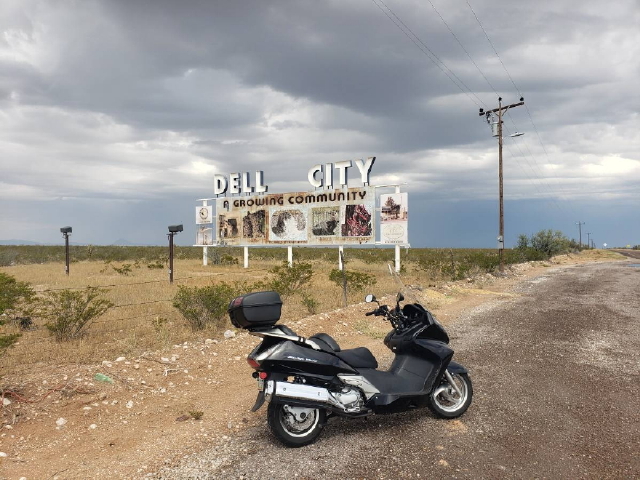The rear wheel brake pads are
very easy to replace (one dust cover and one brake pin) and it does not require a lot of mechanical ability.
Tools:
- Large slotted screwdriver
- 5 MM allen hex wrench
- Torque Wrench (optional)
- Toothbrush
- Long screwdriver or flat metal bar to recess pistons
The rear wheel brake pad replacement instructions are very similar to the front brake pads replacement instructions (
https://www.silverwing600.com/maintenance-tips-and-hints-f7/front-wheel-brake-pad-replacement-instructions-t797.htm#6319 ). As I said in the prior thread, I found the brake pads to be cheaper at http://www.partspitstop.com/pages/parts/viewbybrand/7/Honda.aspx .
My SWing has 36,033 miles and I was preparing for a long trip 3,500-4,000 miles, so I wanted to do a physical inspection of the rear brake pad.
- Remove the "pad pin plug" with a large slotted screwdriver
On the right rear side of the SWing on the lowest-rear portion of the Niffin brake caliper is the location of the "pad pin plug". The "pad pin plug" is a dust/debris cover for the "pad pin" and is only about 1/4" deep.
- Remove the "pad pin" with 5mm allen hex wrench
Beneath the "pad pin plug" above is the "pad pin". The "pad pin" only has threads on outside with a smooth leaner body just holding the brake pads in place. After the "pad pin" is backed out with no more threads appearing, you may have to wiggle the "pad pin" to remove the pin. After the "pad pin is removed the rear brake pads may literally start falling down ... otherwise a tiny amount of movement will allow them to move.
I inspected my rear brakes and they still had more brake pad width available, but since I am planning of a longer trip I still replaced the brake pads. I saved the older pads, since they still had additional pad width for temporary usage if needed.
Here is the the instructions that I followed
Honda Instructions: To provide clearance for new pads, push the caliper pistons all the in by pushing the caliper body inward.
I did not push the caliper pistons in because I wanted to clean with a brush the piston sidewalls to remove the excess
brake dust before recessing the pistons, which I believe would help keep the caliper pistons working better/smoother in the future.
Honda Instructions: Remove the pad pin plug and loosen the pad pin.I had no problem removing the pad pin plug or loosening the pad pin, even
though I ride in the rain. Some people have reported that the pad pin
rusted and was difficult or impossible to remove ... I wonder if that
might be due to winter salt on the roads.
Honda Instructions: Remove the pad pin and the brake
pads.
Install new pads so that their ens rest properly on the pad retainer on the bracket.
I cleaned each caliper piston on all sides with a toothbrush starting the lower one ... after cleaning the piston I held the outside caliper and very lightly pushed the piston flush with a screwdriver. After you recessed the lower piston the next piston was easier to access and clean. There are two separate pistons to clean and recess flush.
From the right side of the rear wheel behind the swingarm, if you shine a light on the
brake calipers you can see the "U" channel ... carefully check to see that the metal spring is still in place.
From the left side of the rear wheel, if you shine a light from behind the final drive and through the wheel at the top of the brake caliper you can see the top of the "U" channel ... carefully check to see the metal spring is still in place.
I cleaned the pad pin with automotive hand cleaner and a small 3M green pad.
I slid the
brake pads into place and pushed the pad pin into place, you could feel the spring give a little when you push the pads up to fit the pad pin in. I turned the pad pin a couple of turns to hold in place while I inspected the top of the
brake pads.
From the right side of the rear wheel behind the swing arm, if you shine a light on the
top of the brake calipers you can see the "U" channel ... carefully check that the top of the right
brake pad is fitting squarely in the "U" channel.
From the left side of the rear wheel behind the final drive, if you shine a light through the wheel at the top of
brake calipers you can see the top of the "U" channel ... carefully check that the top of the left
brake pad is fitting squarely in the "U" channel.
Honda Instructions: Install the pad pin by pushing the pads against the pad spring, aligning the pad pin holes in the pads and the caliper. Tighten the pad pin to the specified torque. Torque: 18 Nm (1.8 kgf-m, 13 lbf-ft)
Tighten "pad pin" to 18 Nm.
Honda Instructions: Install and tighten the pad pin plug to the specified torque.
Torque: 3 Nm (0.3 kgf-m, 2.2 lbf-ft)
I cleaned the pad pin plug with the toothbrush to help keep the pad pin plug securely seated.
If you are riding in winter salted road you might want to add some hot glue (silicone which is easily removable later)
- over the "pad pin plug"
- on the caliper base where the allen screw passes through metal caliper holes (not the
brake pad holes) to prevent moisture and salts from damaging the screw
Before I test drove the SWing, when you pulled the
brake levers there was no resistance so I alternately pumped the left and right
brake levers until the
brake resistance returned ... then I carefully took a test drive with increasing test braking.
